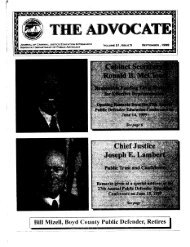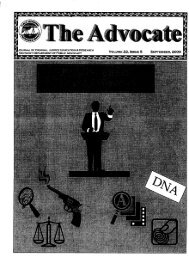May 2002 - Department of Public Advocacy
May 2002 - Department of Public Advocacy
May 2002 - Department of Public Advocacy
Create successful ePaper yourself
Turn your PDF publications into a flip-book with our unique Google optimized e-Paper software.
Continued from page 21<br />
control mechanism has blinded us to the complexity <strong>of</strong> crime<br />
and ways to control it, and has thus encouraged heightened<br />
expectations about the role <strong>of</strong> courts and prisons in providing<br />
public safety. Since by definition these institutions are<br />
reactive systems that come into play after a crime has been<br />
committed, it should hardly be surprising that their role in<br />
controlling crime will always be limited. While most <strong>of</strong> us<br />
recognize intuitively that families, communities, and other<br />
institutions necessarily play a major role in the socialization<br />
process, political demagoguery has promoted the centrality<br />
<strong>of</strong> the criminal justice system as the means by which communities<br />
can be made safer.”<br />
The title <strong>of</strong> the book is a double entendre. Mauer uses the<br />
title to describe the enormous growth in the prison population<br />
over the past 30 years. However, the title is also representative<br />
<strong>of</strong> a significant effect <strong>of</strong> this “race,” and that is on<br />
race relations and on the communities <strong>of</strong> color in this nation.<br />
“At the close <strong>of</strong> the twentieth century, race, crime, and the<br />
criminal justice system are inextricably linked.” (p. 118).<br />
Mauer speaks persuasively through statistics. “Half <strong>of</strong> all<br />
prison inmates are now African American, and another 17<br />
percent are Hispanic…” (p. 118-119). “[A] black boy born in<br />
1991 stood a 29 percent chance <strong>of</strong> being imprisoned at some<br />
point in his life, compared to a 16 percent chance for a Hispanic<br />
boy and a 4 percent chance for a white boy.” (p. 125).<br />
“The degree to which arrest rates may explain the racial composition<br />
<strong>of</strong> the prison population has been examined by criminologist<br />
Alfred Blumstein…[who found] that, with the critical<br />
exception <strong>of</strong> drug <strong>of</strong>fenses, higher rates <strong>of</strong> crime…were<br />
responsible for most <strong>of</strong> the high rate <strong>of</strong> black incarceration.<br />
In the 1991 study, for example, he found that 76 percent <strong>of</strong> the<br />
higher black rate <strong>of</strong> imprisonment was accounted for by higher<br />
THE ADVOCATE Volume 24, No. 3 <strong>May</strong> <strong>2002</strong><br />
Books on: Race and Criminal Justice<br />
rates <strong>of</strong> arrest. The remaining 24 percent <strong>of</strong> disparity might<br />
be explained by racial bias or other factors.” (p. 127). “A<br />
report by the Federal Judicial Center found that in 1990 blacks<br />
were 21 percent more likely and Hispanics 28 percent more<br />
likely than whites to receive a mandatory prison term for<br />
<strong>of</strong>fense behavior that fell under the mandatory sentencing<br />
legislation.” (p. 138-139). Mauer goes on to demonstrate<br />
through data the racial disparities in the death penalty, sentencing,<br />
and the juvenile justice system.<br />
Kentucky public defenders recently conducted a conference<br />
with the joint themes <strong>of</strong> eliminating racial discrimination and<br />
protecting the innocent. It was good that we as defenders<br />
focused for 3 days on the issue <strong>of</strong> race and how race is a<br />
pervasive factor in our criminal justice system. Other systems<br />
have likewise examined the issue <strong>of</strong> race; Chief Justice<br />
Lambert and former Chief Justice Stephens have been notable<br />
leaders in the quest for racial justice in the Kentucky<br />
criminal justice system. Governor Patton issued an Executive<br />
Order outlawing racial pr<strong>of</strong>iling. The Kentucky General<br />
Assembly recently passed the Racial Justice Act, the Racial<br />
Pr<strong>of</strong>iling Act, and the law to streamline the procedure for the<br />
restoration <strong>of</strong> civil rights for convicted felons. Kentucky is<br />
making much progress toward racial justice in our criminal<br />
justice system. Marc Mauer’s book should assist us as we<br />
continue to struggle for racial justice in our criminal justice<br />
system, and should keep us from complacency.<br />
Ernie Lewis<br />
<strong>Public</strong> Advocate<br />
<strong>Department</strong> <strong>of</strong> <strong>Public</strong> <strong>Advocacy</strong><br />
100 Fair Oaks Lane, Ste. 302<br />
Frankfort, Kentucky 40601<br />
Tel: (502) 564-8006; Fax: (502) 564-7890<br />
E-mail: elewis@mail.pa.state.ky.us<br />
The following is a listing <strong>of</strong> books held by DPA on issues<br />
related to Race issues in Criminal Justice. Please see one <strong>of</strong><br />
the librarians for help with locating additional sources, such<br />
as journal articles, videotapes, handouts, or Internet resources.<br />
Black Robes, White Justice. By Bruce Wright. (Secaucus,<br />
NJ, L. Stuart). 1987. KF 373 .W67 A33 1987.<br />
The Death Penalty in Black & White: Who Lives, Who Dies,<br />
Who Decides: New Studies on Racism in Capital Punishment.<br />
By Richard C. Dieter. (Washington, D.C., Death Penalty<br />
Information Center.) 1998. HV 8694 .D53 1998.<br />
Intended and Unintended Consequences: State Racial Disparities<br />
in Imprisonment. By Marc Maurer. (Washington,<br />
D.C., The Sentencing Project). 1997. HV 9950 .M37 1997.<br />
Minorities in Juvenile Justice. By William Feyerherm. (Thousand<br />
Oaks, CA., Sage <strong>Public</strong>ations). 1995. HV 9104 .M57<br />
1995.<br />
No Equal Justice: Race and Class in the American Criminal<br />
Justice System. By David Cole. (New York, New Press).<br />
1999. HV 9950 .C58 1999.<br />
Race to Incarcerate. By Marc Maurer. (New York, NY, New<br />
Press). 1999. HV 9950 .M32 1999.<br />
Racial Violence in Kentucky, 1864-1940: Lynchings, Mob<br />
Rule, and “Legal Lynchings.” By G.C. Wright. (Baton Rouge,<br />
LA, Louisiana State University Press). 1990. HV 6465 .K4<br />
W75 1990.<br />
Us and Them: A History <strong>of</strong> Intolerance in America. By Jim<br />
Carnes and Herbert Tauss. (New York, Oxford University<br />
Press). 1996. E 184 .A1 C335 1996.<br />
Will Hilyerd<br />
Assistant <strong>Public</strong> Advocate<br />
100 Fair Oaks Lane, Suite 302<br />
Frankfort, KY 40601<br />
Tel: (502) 564-8006; Fax: (502) 564-7890<br />
E-mail: whilyerd@mail.pa.state.ky.us<br />
22








